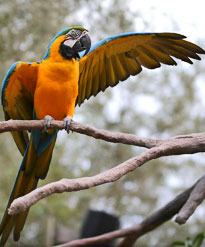
Wing clipping seeks to temporarily remove the capability of flight and limit or modify flight. This is commonly used in pet birds to prevent escape and to control mobility. In clipping the wings, owners should take into consideration the cosmetic appearance and effectiveness of the clipped wings. Owners should also aim to avoid any harm that would result from this procedure.
In the course of grooming pet birds, the use of some physical restraint is inevitable. When done correctly, physical restraint and grooming procedures should not be problematic to companion birds. Otherwise, it can permanently damage the nature of human-bird bonding as well as the doctor/client relationship. Physical restraint in a typical veterinary setting is performed with the use of a towel. The towel is held with the ends draped over each hand while approaching the bird from the front and maintaining eye contact. The bird is shown the towel and then gently wrapped from the front or back. Since the bird is gently wrapped, grooming procedures can be performed respectfully and with effective control. After the procedure, the bird is stepped down from the towel to a perch whereby the bird is called back to provide reassurance and positive reinforcement. Special attention should be given to the alarm calls produced by birds during the procedure, calming them when necessary.
Popular recommendations on how to trim wings include the unilateral and bilateral trims. Unilateral trims have been recommended in the past because they could provide a circular decent and effectively eliminate flight. However, it is not widely accepted as it is viewed as cosmetically unappealing and the circular decent generated was not the typically controlled one for the bird. The bilateral wing trim patterns are multiple and varied. The location of the cut as well as the lengths and angles vary. The primary, secondary and tertiary remiges of the wing may be cut depending on the knowledge, experience and preference of the groomer.
Several problems have been associated with wing trim. Poor restraint techniques easily produce fear and learned behavior patters of resistance. The incidences of loss of stabilization after the wing trim making the birds more vulnerable to falling are far too many. A hard or uncontrollable fall can result in a progressive loss of trust between bird and owner which usually leads to biting or refusal to respond to the “step-up” command. Injuries such as these result to physical pain and can further escalate the feelings of distrust.
Physical and psychologically traumatic experiences over time, increases the bird’s vulnerability to psychogenic illness. Manifestations are seen through self-damaging events such as feather pulling, feather mutilation and other self-mutilatory behavior. Grooming procedures which are done even for the good of the bird should be tempered by one thing: Do no harm to the bird.